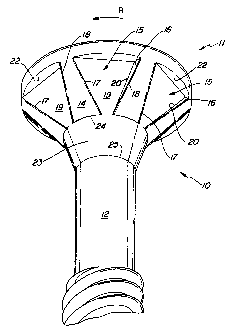Une partie des informations de ce site Web a été fournie par des sources externes. Le gouvernement du Canada n'assume aucune responsabilité concernant la précision, l'actualité ou la fiabilité des informations fournies par les sources externes. Les utilisateurs qui désirent employer cette information devraient consulter directement la source des informations. Le contenu fourni par les sources externes n'est pas assujetti aux exigences sur les langues officielles, la protection des renseignements personnels et l'accessibilité.
L'apparition de différences dans le texte et l'image des Revendications et de l'Abrégé dépend du moment auquel le document est publié. Les textes des Revendications et de l'Abrégé sont affichés :
| (12) Brevet: | (11) CA 2198832 |
|---|---|
| (54) Titre français: | VIS A AUTO-FRAISAGE |
| (54) Titre anglais: | SELF COUNTER-SINKING SCREW |
| Statut: | Durée expirée - au-delà du délai suivant l'octroi |
| (51) Classification internationale des brevets (CIB): |
|
|---|---|
| (72) Inventeurs : |
|
| (73) Titulaires : |
|
| (71) Demandeurs : |
|
| (74) Agent: | GOWLING WLG (CANADA) LLP |
| (74) Co-agent: | |
| (45) Délivré: | 2002-04-16 |
| (22) Date de dépôt: | 1997-02-28 |
| (41) Mise à la disponibilité du public: | 1997-09-27 |
| Requête d'examen: | 1999-07-20 |
| Licence disponible: | S.O. |
| Cédé au domaine public: | S.O. |
| (25) Langue des documents déposés: | Anglais |
| Traité de coopération en matière de brevets (PCT): | Non |
|---|
| (30) Données de priorité de la demande: | ||||||
|---|---|---|---|---|---|---|
|
Vis à autofraisage comprenant une portion de tête conique inversée formée au niveau d'un couvercle avec une cavité adaptée pour loger une pointe d'un tournevis et doté d'un fond conique, ledit fond conique ayant une pluralité de retraits triangulaires chacun ayant un côté latéral s'étendant vers l'intérieur pour former un bord aigu et un espace pour recevoir des copeaux, une portion filetée, et une portion décroissante dotée d'un diamètre plus large connectée avec la portion de tête et un diamètre plus petit connecté avec la portion filetée, dans laquelle le bord aigu fait un fraisage sur une pièce de travail lorsque la tête de vis fraisée est tournée dans celui-ci.
A self-countersinking screw including an inverted-conical head portion formed at a top with a cavity adapted to receive a tip of a screwdriver and having a conical bottom, said conical bottom having a plurality of triangular recesses each having a lateral side extending inwardly to form a sharp edge and a space for receiving chips, a threaded portion, and a tapered portion having a large diameter connected with the head portion and a small diameter connected with the threaded portion, whereby the sharp edge will make a countersink on a workpiece when the countersunk head screw is turned therein.
Note : Les revendications sont présentées dans la langue officielle dans laquelle elles ont été soumises.
Note : Les descriptions sont présentées dans la langue officielle dans laquelle elles ont été soumises.

2024-08-01 : Dans le cadre de la transition vers les Brevets de nouvelle génération (BNG), la base de données sur les brevets canadiens (BDBC) contient désormais un Historique d'événement plus détaillé, qui reproduit le Journal des événements de notre nouvelle solution interne.
Veuillez noter que les événements débutant par « Inactive : » se réfèrent à des événements qui ne sont plus utilisés dans notre nouvelle solution interne.
Pour une meilleure compréhension de l'état de la demande ou brevet qui figure sur cette page, la rubrique Mise en garde , et les descriptions de Brevet , Historique d'événement , Taxes périodiques et Historique des paiements devraient être consultées.
| Description | Date |
|---|---|
| Inactive : Périmé (brevet - nouvelle loi) | 2017-02-28 |
| Lettre envoyée | 2011-04-15 |
| Inactive : Transfert individuel | 2011-04-05 |
| Inactive : CIB de MCD | 2006-03-12 |
| Accordé par délivrance | 2002-04-16 |
| Inactive : Page couverture publiée | 2002-04-15 |
| Préoctroi | 2001-12-19 |
| Inactive : Taxe finale reçue | 2001-12-19 |
| Un avis d'acceptation est envoyé | 2001-12-12 |
| Lettre envoyée | 2001-12-12 |
| Un avis d'acceptation est envoyé | 2001-12-12 |
| Inactive : Approuvée aux fins d'acceptation (AFA) | 2001-11-29 |
| Modification reçue - modification volontaire | 2001-08-21 |
| Inactive : Dem. de l'examinateur par.30(2) Règles | 2001-04-23 |
| Lettre envoyée | 1999-08-31 |
| Exigences pour une requête d'examen - jugée conforme | 1999-07-20 |
| Toutes les exigences pour l'examen - jugée conforme | 1999-07-20 |
| Modification reçue - modification volontaire | 1999-07-20 |
| Requête d'examen reçue | 1999-07-20 |
| Demande publiée (accessible au public) | 1997-09-27 |
| Inactive : CIB en 1re position | 1997-07-03 |
| Inactive : CIB attribuée | 1997-07-03 |
| Inactive : Demandeur supprimé | 1997-06-19 |
| Inactive : Inventeur supprimé | 1997-06-19 |
| Inactive : Demandeur supprimé | 1997-06-19 |
| Inactive : Inventeur supprimé | 1997-06-19 |
| Inactive : Inventeur supprimé | 1997-06-13 |
| Inactive : Inventeur supprimé | 1997-06-13 |
Il n'y a pas d'historique d'abandonnement
Le dernier paiement a été reçu le 2002-01-28
Avis : Si le paiement en totalité n'a pas été reçu au plus tard à la date indiquée, une taxe supplémentaire peut être imposée, soit une des taxes suivantes :
Veuillez vous référer à la page web des taxes sur les brevets de l'OPIC pour voir tous les montants actuels des taxes.
Les titulaires actuels et antérieures au dossier sont affichés en ordre alphabétique.
| Titulaires actuels au dossier |
|---|
| ULI WALTHER |
| GERDA WALTHER |
| MIRCO WALTHER |
| Titulaires antérieures au dossier |
|---|
| CHAO - HSIN (MICHAEL) YU |